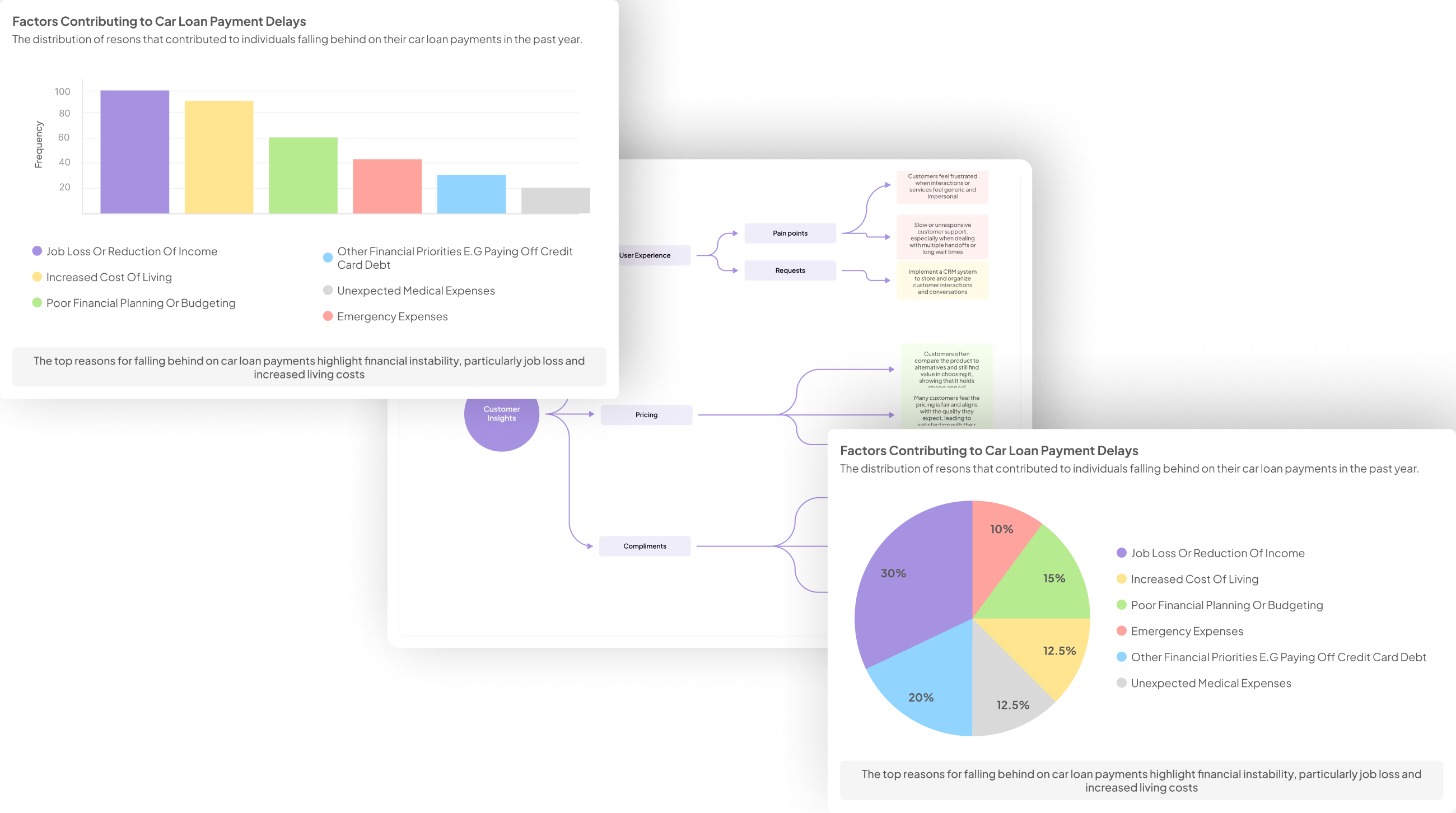How to Analyze Buyer Meetings
-
Bella Williams
- 10 min read
Buyer Meeting Analysis is crucial for understanding the nuances of customer interactions. Picture this: a sales representative shifts from simply taking orders to genuinely consulting with clients. This transition is not only beneficial for closing deals but also enhances overall customer satisfaction. An effective analysis of buyer meetings provides insights into what customers want and how businesses can better meet those needs.
In today's competitive environment, companies must adopt a consultative approach to engage buyers meaningfully. By focusing on analyzing these meetings, organizations can refine their strategies, improve training, and adjust offerings based on real market demands. Ultimately, diving deep into buyer meeting analysis equips businesses with the knowledge to foster stronger client relationships and drive growth.
Generate visualizations from your qualitative data. At Scale.

Understanding Buyer Meeting Analysis
Buyer Meeting Analysis is essential for understanding how to enhance the effectiveness of sales interactions. This analysis focuses on evaluating various aspects of buyer meetings, including communication effectiveness, client engagement, and overall meeting outcomes. By closely examining these components, organizations can pinpoint strengths and weaknesses, facilitating continuous improvement in their sales strategies.
One crucial element to consider in Buyer Meeting Analysis is the creation of evaluation criteria. Establishing clear benchmarks is essential for assessing performance accurately. For instance, you might evaluate how well the sales representative addressed client needs, the clarity of the information provided, and the overall flow of conversation. Once defined, this criteria can serve as the foundation for scoring calls, leading to actionable insights that can drive future interactions. This structured approach not only promotes effective decision-making but also fosters a culture of accountability and continuous development among sales teams.
Key Components of Buyer Meeting Analysis
To conduct an effective Buyer Meeting Analysis, it's important to focus on key components that drive success. First, understanding the types of interactions that occur during meetings lays the groundwork for effective evaluation. Different categories, such as regulatory compliance, service delivery, and product knowledge, highlight varying aspects of buyer needs. Tracking these elements helps pinpoint both strengths and weaknesses in communication strategies.
Next, capturing specific details is essential for future analysis. This involves documenting questions about pricing or service inquiries that buyers often raise. By categorizing this data, you can create a nuanced perspective on buyer intentions, which significantly enhances your understanding of market dynamics. Ultimately, integrating these critical components into your analysis process allows for more informed decision-making, enabling teams to refine their approaches and improve sales conversion rates.
Benefits of Analyzing Buyer Meetings
Analyzing buyer meetings offers several distinct advantages for businesses. First, it helps in understanding customer perspectives by capturing their feedback and concerns effectively. This insight can enhance decision-making processes, as businesses become more aligned with buyer needs and expectations. Secondly, analysis allows teams to identify trends and patterns in buyer behavior, providing valuable data that can inform future product development and marketing strategies.
Additionally, thorough Buyer Meeting Analysis enhances team collaboration and communication. By sharing insights across departments, everyone gains clarity on customer preferences, fostering a unified approach to meeting buyer demands. Lastly, this analysis can lead to improved sales strategies. By understanding what resonates during meetings, sales teams can refine their pitches and increase conversion rates. In summary, the benefits of analyzing buyer meetings extend beyond immediate feedback, supporting long-term business growth and adaptability.
Evaluate Performance on Customer Calls for Quality Assurance.
Steps to Conduct a Comprehensive Buyer Meeting Analysis
To conduct a comprehensive Buyer Meeting Analysis, begin by preparing effectively. Preparation involves defining your objectives and establishing criteria for what constitutes a successful buyer meeting. This framework helps in identifying the key areas to focus on during the analysis process. Ensure you gather necessary documentation that outlines expected outcomes, including metrics like lead qualification and buyer engagement levels.
Next, collect and organize relevant data from your meetings. This can be done by reviewing recordings or notes, categorizing responses, and highlighting significant interactions. Once the data is organized, analyze the insights drawn from buyer interactions. Look for patterns that indicate buyer preferences, challenges, and potential opportunities. Finally, draw actionable insights from this analysis to inform your sales strategies, enhance buyer engagement, and improve future meetings. By following these steps, you can ensure a thorough and effective Buyer Meeting Analysis that drives meaningful outcomes.
Step 1: Preparation for the Analysis
To effectively prepare for buyer meeting analysis, begin by collecting all relevant materials. This includes meeting notes, transcripts, and recordings of prior interactions. Understanding what took place in these meetings lays the groundwork for deeper insights. Furthermore, having a clear objective makes the analysis process smoother. Be specific about what you want to learn from the analysis, whether it’s evaluating buyer engagement or identifying trends.
Next, establish a framework for your analysis. Define criteria that will help assess the quality of interactions. This might encompass areas such as communication effectiveness, compliance with guidelines, or overall buyer satisfaction. By setting these parameters, the analysis becomes targeted and purposeful. With preparation in place, you'll be ready to conduct a thorough buyer meeting analysis, paving the way for actionable insights and improved strategies.
Step 2: Data Collection and Organization
In buyer meeting analysis, effective data collection and organization are crucial for extracting meaningful insights. Begin by gathering data from various sources like call transcripts, meeting notes, and feedback forms. Organizing this data systematically ensures you can easily analyze performance and identify patterns. Consider grouping data by location, representative, or product type to facilitate a clearer understanding of each area’s strengths and weaknesses.
Next, develop a structure that allows for comparison. You might want to create a dashboard showing individual performance against team benchmarks. This approach not only highlights individual achievements but also encourages friendly competition among team members. The goal is to cultivate a comprehensive view of buyer interactions. As you progress, keep refining your data organization strategies to adapt to new insights and improve future analyses. This structured approach will significantly enhance your overall buyer meeting analysis and lead to more informed decision-making.
Step 3: Analyzing Buyer Interactions
In Step 3: Analyzing Buyer Interactions, you delve deeper into the nuances of buyer meetings to better understand their dynamics. Effective analysis hinges on observing patterns in communication, responses, and overall engagement during interactions. By carefully dissecting the content and flow of these conversations, you can identify key takeaways that inform future strategies.
When conducting your analysis, focus on three main areas: the emotional tone of the discussions, the clarity of buyer needs, and any common questions raised. Evaluating the emotional tone can reveal how buyers feel about your offerings. Assessing the clarity of buyer needs helps ensure your responses align with their expectations. Lastly, noting recurring questions allows you to address gaps in knowledge more effectively. By systematically analyzing buyer interactions, you gather vital insights that shape your decision-making and enhance your overall engagement strategy.
Step 4: Drawing Actionable Insights
To effectively draw actionable insights from buyer meetings, it is essential to distill key observations into meaningful takeaways. Begin by organizing the insights gathered during the analysis phase. This could include identifying recurring themes, customer pain points, and positive experiences shared during conversations. Each of these elements represents a potential opportunity for product or service improvement.
Additionally, you should categorize the insights to highlight the most pressing needs of buyers. For example, prioritize problems that were mentioned frequently across multiple meetings. This approach provides clarity on what resonates with customers. By taking structured steps to analyze buyer interactions, teams can formulate strategies that directly address these insights, enhancing both customer satisfaction and business performance. Ultimately, the goal of a buyer meeting analysis is to transform collected data into practical actions that lead to informed decision-making and improved customer experiences.
Conclusion: Enhancing Decisions through Buyer Meeting Analysis
Analyzing buyer meetings offers a powerful opportunity to enhance decision-making processes. By distilling data from these interactions, organizations can uncover valuable insights that shape project directions and optimize product offerings. This analysis not only identifies emerging trends but also captures feedback that informs future strategies. Understanding buyer sentiments enables informed decisions that align closely with customer needs.
Ultimately, effectively leveraging buyer meeting analysis leads to improved outcomes through data-driven strategies. As organizations continue to refine their approach, embracing this analysis will foster agility in navigating market changes and strengthen their competitive position. Investing time in this process can yield significant dividends in understanding and responding to customer expectations.







